Sriram Ganapathy
ABHINAYA -- A System for Speech Emotion Recognition In Naturalistic Conditions Challenge
May 23, 2025Abstract:Speech emotion recognition (SER) in naturalistic settings remains a challenge due to the intrinsic variability, diverse recording conditions, and class imbalance. As participants in the Interspeech Naturalistic SER Challenge which focused on these complexities, we present Abhinaya, a system integrating speech-based, text-based, and speech-text models. Our approach fine-tunes self-supervised and speech large language models (SLLM) for speech representations, leverages large language models (LLM) for textual context, and employs speech-text modeling with an SLLM to capture nuanced emotional cues. To combat class imbalance, we apply tailored loss functions and generate categorical decisions through majority voting. Despite one model not being fully trained, the Abhinaya system ranked 4th among 166 submissions. Upon completion of training, it achieved state-of-the-art performance among published results, demonstrating the effectiveness of our approach for SER in real-world conditions.
Audio-to-Audio Emotion Conversion With Pitch And Duration Style Transfer
May 23, 2025Abstract:Given a pair of source and reference speech recordings, audio-to-audio (A2A) style transfer involves the generation of an output speech that mimics the style characteristics of the reference while preserving the content and speaker attributes of the source. In this paper, we propose a novel framework, termed as A2A Zero-shot Emotion Style Transfer (A2A-ZEST), that enables the transfer of reference emotional attributes to the source while retaining its speaker and speech contents. The A2A-ZEST framework consists of an analysis-synthesis pipeline, where the analysis module decomposes speech into semantic tokens, speaker representations, and emotion embeddings. Using these representations, a pitch contour estimator and a duration predictor are learned. Further, a synthesis module is designed to generate speech based on the input representations and the derived factors. This entire paradigm of analysis-synthesis is trained purely in a self-supervised manner with an auto-encoding loss. For A2A emotion style transfer, the emotion embedding extracted from the reference speech along with the rest of the representations from the source speech are used in the synthesis module to generate the style translated speech. In our experiments, we evaluate the converted speech on content/speaker preservation (w.r.t. source) as well as on the effectiveness of the emotion style transfer (w.r.t. reference). The proposal, A2A-ZEST, is shown to improve over other prior works on these evaluations, thereby enabling style transfer without any parallel training data. We also illustrate the application of the proposed work for data augmentation in emotion recognition tasks.
Benchmarking and Confidence Evaluation of LALMs For Temporal Reasoning
May 19, 2025Abstract:The popular success of text-based large language models (LLM) has streamlined the attention of the multimodal community to combine other modalities like vision and audio along with text to achieve similar multimodal capabilities. In this quest, large audio language models (LALMs) have to be evaluated on reasoning related tasks which are different from traditional classification or generation tasks. Towards this goal, we propose a novel dataset called temporal reasoning evaluation of audio (TREA). We benchmark open-source LALMs and observe that they are consistently behind human capabilities on the tasks in the TREA dataset. While evaluating LALMs, we also propose an uncertainty metric, which computes the invariance of the model to semantically identical perturbations of the input. Our analysis shows that the accuracy and uncertainty metrics are not necessarily correlated and thus, points to a need for wholesome evaluation of LALMs for high-stakes applications.
Spoken Language Understanding on Unseen Tasks With In-Context Learning
May 12, 2025Abstract:Spoken language understanding (SLU) tasks involve diverse skills that probe the information extraction, classification and/or generation capabilities of models. In this setting, task-specific training data may not always be available. While traditional task-specific SLU models are unable to cater to such requirements, the speech-text large language models (LLMs) offer a promising alternative with emergent abilities. However, out of-the-box, our evaluations indicate that the zero/few-shot performance of prominent open-source speech-text LLMs on SLU tasks are not up to the mark. In this paper, we introduce a novel approach to robust task-agnostic fine-tuning using randomized class labels. With this proposed fine-tuning, we illustrate that the performance of the speech-text LLMs on an unseen task is significantly improved over standard approaches. Critically, the proposed approach avoids the requirement of task-specific data annotations for enabling new tasks in speech-text LLMs.
LLM supervised Pre-training for Multimodal Emotion Recognition in Conversations
Jan 20, 2025



Abstract:Emotion recognition in conversations (ERC) is challenging due to the multimodal nature of the emotion expression. In this paper, we propose to pretrain a text-based recognition model from unsupervised speech transcripts with LLM guidance. These transcriptions are obtained from a raw speech dataset with a pre-trained ASR system. A text LLM model is queried to provide pseudo-labels for these transcripts, and these pseudo-labeled transcripts are subsequently used for learning an utterance level text-based emotion recognition model. We use the utterance level text embeddings for emotion recognition in conversations along with speech embeddings obtained from a recently proposed pre-trained model. A hierarchical way of training the speech-text model is proposed, keeping in mind the conversational nature of the dataset. We perform experiments on three established datasets, namely, IEMOCAP, MELD, and CMU- MOSI, where we illustrate that the proposed model improves over other benchmarks and achieves state-of-the-art results on two out of these three datasets.
Uncovering the role of semantic and acoustic cues in normal and dichotic listening
Nov 18, 2024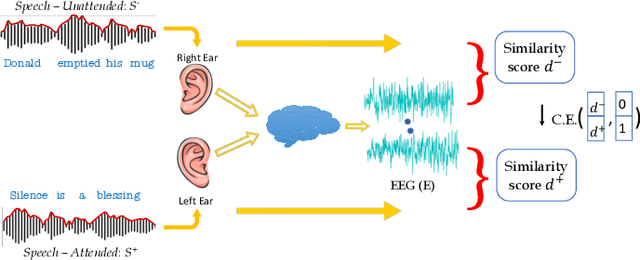
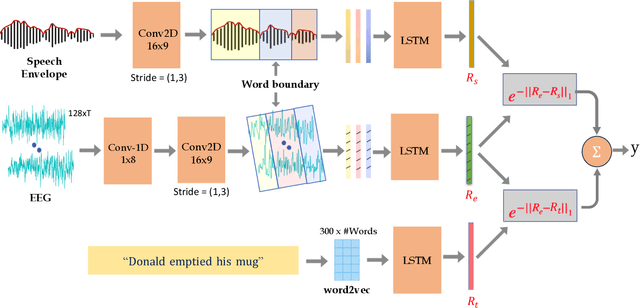
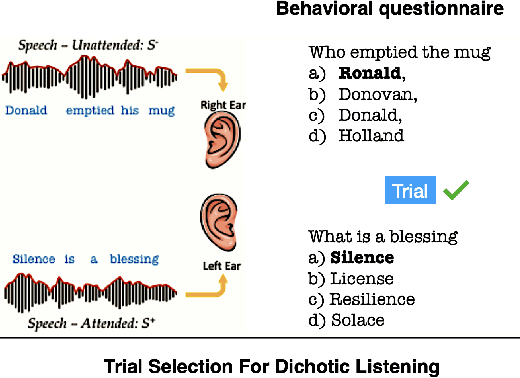

Abstract:Despite extensive research, the precise role of acoustic and semantic cues in complex speech perception tasks remains unclear. In this study, we propose a paradigm to understand the encoding of these cues in electroencephalogram (EEG) data, using match-mismatch (MM) classification task. The MM task involves determining whether the stimulus and response correspond to each other or not. We design a multi-modal sequence model, based on long short term memory (LSTM) architecture, to perform the MM task. The model is input with acoustic stimulus (derived from the speech envelope), semantic stimulus (derived from textual representations of the speech content), and neural response (derived from the EEG data). Our experiments are performed on two separate conditions, i) natural passive listening condition and, ii) an auditory attention based dichotic listening condition. Using the MM task as the analysis framework, we observe that - a) speech perception is fragmented based on word boundaries, b) acoustic and semantic cues offer similar levels of MM task performance in natural listening conditions, and c) semantic cues offer significantly improved MM classification over acoustic cues in dichotic listening task. Further, the study provides evidence of right ear advantage in dichotic listening conditions.
Gradient-free Post-hoc Explainability Using Distillation Aided Learnable Approach
Sep 17, 2024



Abstract:The recent advancements in artificial intelligence (AI), with the release of several large models having only query access, make a strong case for explainability of deep models in a post-hoc gradient free manner. In this paper, we propose a framework, named distillation aided explainability (DAX), that attempts to generate a saliency-based explanation in a model agnostic gradient free application. The DAX approach poses the problem of explanation in a learnable setting with a mask generation network and a distillation network. The mask generation network learns to generate the multiplier mask that finds the salient regions of the input, while the student distillation network aims to approximate the local behavior of the black-box model. We propose a joint optimization of the two networks in the DAX framework using the locally perturbed input samples, with the targets derived from input-output access to the black-box model. We extensively evaluate DAX across different modalities (image and audio), in a classification setting, using a diverse set of evaluations (intersection over union with ground truth, deletion based and subjective human evaluation based measures) and benchmark it with respect to $9$ different methods. In these evaluations, the DAX significantly outperforms the existing approaches on all modalities and evaluation metrics.
Leveraging Content and Acoustic Representations for Efficient Speech Emotion Recognition
Sep 09, 2024



Abstract:Speech emotion recognition (SER), the task of identifying the expression of emotion from spoken content, is challenging due to the difficulty in extracting representations that capture emotional attributes from speech. The scarcity of large labeled datasets further complicates the challenge where large models are prone to over-fitting. In this paper, we propose CARE (Content and Acoustic Representations of Emotions), where we design a dual encoding scheme which emphasizes semantic and acoustic factors of speech. While the semantic encoder is trained with the distillation of utterance-level text representation model, the acoustic encoder is trained to predict low-level frame-wise features of the speech signal. The proposed dual encoding scheme is a base-sized model trained only on unsupervised raw speech. With a simple light-weight classification model trained on the downstream task, we show that the CARE embeddings provide effective emotion recognition on a variety of tasks. We compare the proposal with several other self-supervised models as well as recent large-language model based approaches. In these evaluations, the proposed CARE model is shown to be the best performing model based on average performance across 8 diverse datasets. We also conduct several ablation studies to analyze the importance of various design choices.
STAB: Speech Tokenizer Assessment Benchmark
Sep 04, 2024
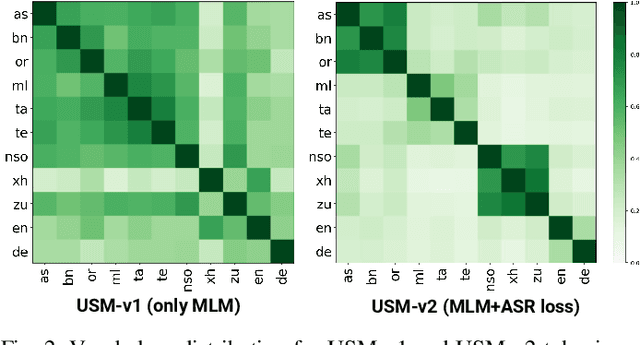
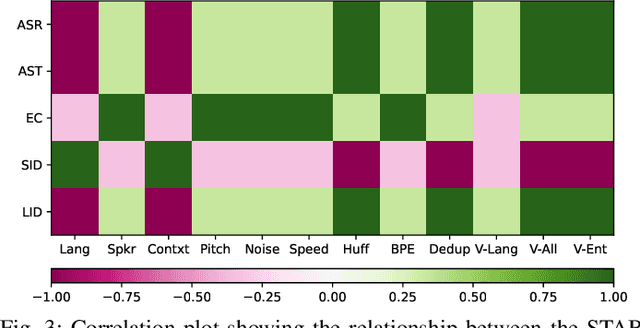
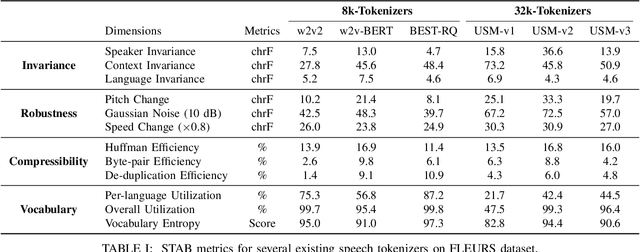
Abstract:Representing speech as discrete tokens provides a framework for transforming speech into a format that closely resembles text, thus enabling the use of speech as an input to the widely successful large language models (LLMs). Currently, while several speech tokenizers have been proposed, there is ambiguity regarding the properties that are desired from a tokenizer for specific downstream tasks and its overall generalizability. Evaluating the performance of tokenizers across different downstream tasks is a computationally intensive effort that poses challenges for scalability. To circumvent this requirement, we present STAB (Speech Tokenizer Assessment Benchmark), a systematic evaluation framework designed to assess speech tokenizers comprehensively and shed light on their inherent characteristics. This framework provides a deeper understanding of the underlying mechanisms of speech tokenization, thereby offering a valuable resource for expediting the advancement of future tokenizer models and enabling comparative analysis using a standardized benchmark. We evaluate the STAB metrics and correlate this with downstream task performance across a range of speech tasks and tokenizer choices.
Improving Self-supervised Pre-training using Accent-Specific Codebooks
Jul 04, 2024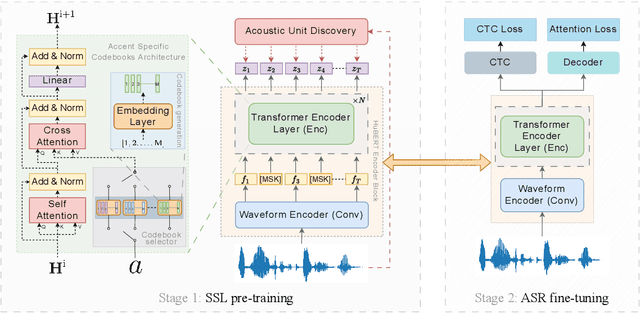



Abstract:Speech accents present a serious challenge to the performance of state-of-the-art end-to-end Automatic Speech Recognition (ASR) systems. Even with self-supervised learning and pre-training of ASR models, accent invariance is seldom achieved. In this work, we propose an accent-aware adaptation technique for self-supervised learning that introduces a trainable set of accent-specific codebooks to the self-supervised architecture. These learnable codebooks enable the model to capture accent specific information during pre-training, that is further refined during ASR finetuning. On the Mozilla Common Voice dataset, our proposed approach outperforms all other accent-adaptation approaches on both seen and unseen English accents, with up to 9% relative reduction in word error rate (WER).
 Add to Chrome
Add to Chrome Add to Firefox
Add to Firefox Add to Edge
Add to Edge